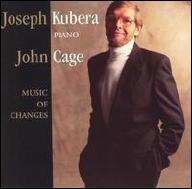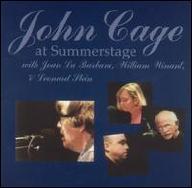Cage was born in Los Angeles on September 5, 1912, the son of an inventor who posited an explanation of the cosmos called the "Electrostatic Field Theory." Later attending Pomona College, he exited prior to graduation to travel across Europe during the early '30s; upon returning to the U.S., he studied in New York with Henry Cowell, finally traveling back to the West Coast in 1934 to study under Arnold Schoenberg. Around this time Cage published his earliest compositions, a series of Varèse-inspired works written in a rigorous atonal system of his own device. Relocating to Seattle in 1937 to become a dance accompanist, a year later he founded a percussion ensemble, composing the seminal polyrhythms piece First Construction (In Metal) in 1939.
During the late 1930s, Cage also began experimenting with musique concrète, composing the landmark Imaginary Landscape No. 1, which employed variable-speed phonographs and frequency tone recordings alongside muted piano and a large Chinese cymbal. He also invented the "prepared piano," in which he placed a variety of household objects between the strings of a grand piano to create sounds suggesting a one-man percussion orchestra. It was at this time that Cage fell under the sway of Eastern philosophies, the influence of Zen Buddhism informing the random compositional techniques of his later work; obsessed with removing forethought and choice from the creative model, he set out to make music in line with the principles of the I Ching, predictable only by its very unpredictability.
Cage's work of the 1940s took a variety of shapes: where 1941's Imaginary Landscape No. 2 was a score for percussion which included a giant metal coil amplified by a phonograph cartridge, 1942's Williams Mix was a montage of over 500 prerecorded sounds, and 1944's The Perilous Night was an emotional piece written for a heavily muted prepared piano. The latter was composed for the Merce Cunningham Dance Company, for which Cage served as musical director from 1943 onward; his collaborations with Cunningham revolutionized modern dance composition and choreography, with the indeterminacy concept extending into these works as well. His most widely recorded work, the Sonatas and Interludes for prepared piano, appeared in 1948. By the end of the decade Cage's innovations were widely recognized, and in 1949 he was honored with a Guggenheim Fellowship and an award from the National Academy of Arts and Letters.
Cage's most visionary work, however, was still to come. In 1951, he completed Imaginary Landscape No. 4, which limited its sound sources to only a dozen radios, with the end result dependent entirely on the broadcast material at the time of performance. That same year, he collaborated with a group of performers and engineers to mount the Music on Magnetic Tape project In 1952, pianist and longtime associate David Tudor premiered Cage's 4'33", known colloquially as Silence (and officially as 4'33"), the composer's most notorious work, the performer sits at his instrument but plays nothing; the environmental sounds are instead produced by a typically uncomfortable audience. Concurrently, he delved into theatrical performance (a 1952 performance at Black Mountain College widely regarded as the first "happening") and electronics (Imaginary Landscape No. 5, composed for randomly mixed recordings).
In the wake of 1958's watershed Concert for Piano and Orchestra -- a virtual catalog of indeterminate notations -- Cage continued to immerse himself in electronics as the years went by, most famously in works like 1960's Cartridge Music, for which he amplified small household sounds for live performance, as well as 1969's HPSCHD, which combined harpsichord, tapes, and the like. He also turned to writing, publishing his first book, Silence, in 1961, additionally teaching and lecturing across the globe. Elected to the Institute of the American Academy and Institute of Arts and Letters in 1968, he also received an honorary Doctorate of Performing Arts from the California Institutes of the Arts in 1986. Cage died in New York on August 12, 1992. ~ Jason Ankeny, Rovi


















